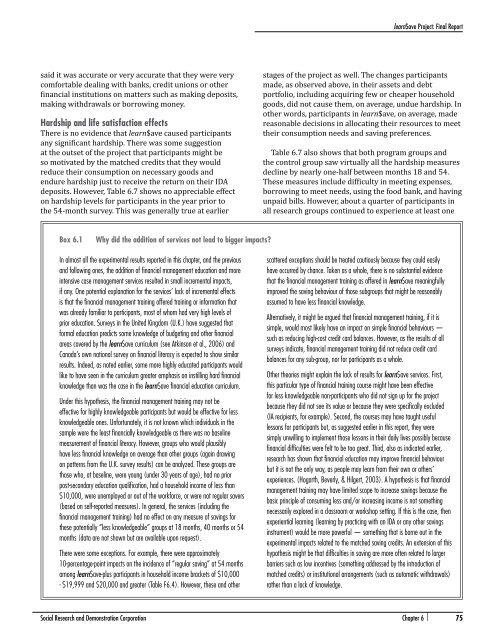Full report. - Social Research and Demonstration Corp
Full report. - Social Research and Demonstration Corp
Full report. - Social Research and Demonstration Corp
You also want an ePaper? Increase the reach of your titles
YUMPU automatically turns print PDFs into web optimized ePapers that Google loves.
learn$ave Project: Final Reportsaid it was accurate or very accurate that they were verycomfortable dealing with banks, credit unions or otherfinancial institutions on matters such as making deposits,making withdrawals or borrowing money.Hardship <strong>and</strong> life satisfaction effectsThere is no evidence that learn$ave caused participantsany significant hardship. There was some suggestionat the outset of the project that participants might beso motivated by the matched credits that they wouldreduce their consumption on necessary goods <strong>and</strong>endure hardship just to receive the return on their IDAdeposits. However, Table 6.7 shows no appreciable effecton hardship levels for participants in the year prior tothe 54-month survey. This was generally true at earlierstages of the project as well. The changes participantsmade, as observed above, in their assets <strong>and</strong> debtportfolio, including acquiring few or cheaper householdgoods, did not cause them, on average, undue hardship. Inother words, participants in learn$ave, on average, madereasonable decisions in allocating their resources to meettheir consumption needs <strong>and</strong> saving preferences.Table 6.7 also shows that both program groups <strong>and</strong>the control group saw virtually all the hardship measuresdecline by nearly one-half between months 18 <strong>and</strong> 54.These measures include difficulty in meeting expenses,borrowing to meet needs, using the food bank, <strong>and</strong> havingunpaid bills. However, about a quarter of participants inall research groups continued to experience at least oneBox 6.1Why did the addition of services not lead to bigger impacts?In almost all the experimental results <strong>report</strong>ed in this chapter, <strong>and</strong> the previous<strong>and</strong> following ones, the addition of financial management education <strong>and</strong> moreintensive case management services resulted in small incremental impacts,if any. One potential explanation for the services’ lack of incremental effectsis that the financial management training offered training or information thatwas already familiar to participants, most of whom had very high levels ofprior education. Surveys in the United Kingdom (U.K.) have suggested thatformal education predicts some knowledge of budgeting <strong>and</strong> other financialareas covered by the learn$ave curriculum (see Atkinson et al., 2006) <strong>and</strong>Canada’s own national survey on financial literacy is expected to show similarresults. Indeed, as noted earlier, some more highly educated participants wouldlike to have seen in the curriculum greater emphasis on instilling hard financialknowledge than was the case in the learn$ave financial education curriculum.Under this hypothesis, the financial management training may not beeffective for highly knowledgeable participants but would be effective for lessknowledgeable ones. Unfortunately, it is not known which individuals in thesample were the least financially knowledgeable as there was no baselinemeasurement of financial literacy. However, groups who would plausiblyhave less financial knowledge on average than other groups (again drawingon patterns from the U.K. survey results) can be analyzed. These groups arethose who, at baseline, were young (under 30 years of age), had no priorpost-secondary education qualification, had a household income of less than$10,000, were unemployed or out of the workforce, or were not regular savers(based on self-<strong>report</strong>ed measures). In general, the services (including thefinancial management training) had no effect on any measure of savings forthese potentially “less knowledgeable” groups at 18 months, 40 months or 54months (data are not shown but are available upon request).There were some exceptions. For example, there were approximately10-percentage-point impacts on the incidence of “regular saving” at 54 monthsamong learn$ave-plus participants in household income brackets of $10,000- $19,999 <strong>and</strong> $20,000 <strong>and</strong> greater (Table F6.4). However, these <strong>and</strong> otherscattered exceptions should be treated cautiously because they could easilyhave occurred by chance. Taken as a whole, there is no substantial evidencethat the financial management training as offered in learn$ave meaningfullyimproved the saving behaviour of those subgroups that might be reasonablyassumed to have less financial knowledge.Alternatively, it might be argued that financial management training, if it issimple, would most likely have an impact on simple financial behaviours —such as reducing high-cost credit card balances. However, as the results of allsurveys indicate, financial management training did not reduce credit cardbalances for any sub-group, nor for participants as a whole.Other theories might explain the lack of results for learn$ave services. First,this particular type of financial training course might have been effectivefor less knowledgeable non-participants who did not sign up for the projectbecause they did not see its value or because they were specifically excluded(IA recipients, for example). Second, the courses may have taught usefullessons for participants but, as suggested earlier in this <strong>report</strong>, they weresimply unwilling to implement those lessons in their daily lives possibly becausefinancial difficulties were felt to be too great. Third, also as indicated earlier,research has shown that financial education may improve financial behaviourbut it is not the only way, as people may learn from their own or others’experiences. (Hogarth, Beverly, & Hilgert, 2003). A hypothesis is that financialmanagement training may have limited scope to increase savings because thebasic principle of consuming less <strong>and</strong>/or increasing income is not somethingnecessarily explored in a classroom or workshop setting. If this is the case, thenexperiential learning (learning by practicing with an IDA or any other savingsinstrument) would be more powerful — something that is borne out in theexperimental impacts related to the matched saving credits. An extension of thishypothesis might be that difficulties in saving are more often related to largerbarriers such as low incentives (something addressed by the introduction ofmatched credits) or institutional arrangements (such as automatic withdrawals)rather than a lack of knowledge.<strong>Social</strong> <strong>Research</strong> <strong>and</strong> <strong>Demonstration</strong> <strong>Corp</strong>oration Chapter 6 | 75




